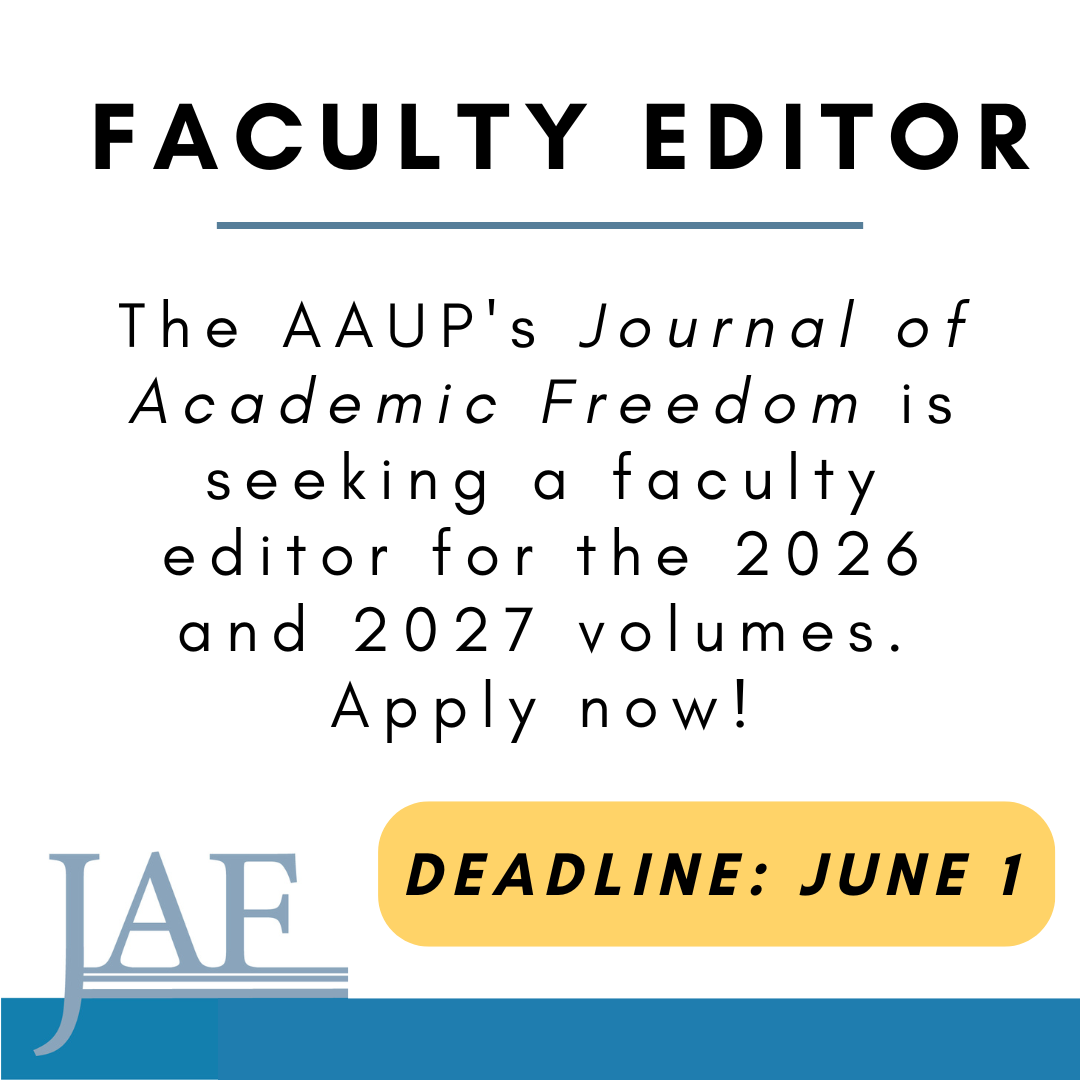- About
- Programs
- Issues
- Academic Freedom
- Political Attacks on Higher Education
- Resources on Collective Bargaining
- Shared Governance
- Campus Protests
- Faculty Compensation
- Racial Justice
- Diversity in Higher Ed
- Financial Crisis
- Privatization and OPMs
- Contingent Faculty Positions
- Tenure
- Workplace Issues
- Gender and Sexuality in Higher Ed
- Targeted Harassment
- Intellectual Property & Copyright
- Civility
- The Family and Medical Leave Act
- Pregnancy in the Academy
- Publications
- Data
- News
- Membership
- Chapters
Learning through the Pandemic
Transactional online education is failing our students.

The COVID-19 pandemic has reignited the perennial debate about whether distance learning will replace brick-and-mortar higher education. We work at the York College campus of the City University of New York in Jamaica, Queens. CUNY is the country’s largest urban public university and is located in one of the early epicenters of the pandemic. We moved to online teaching and learning in mid-March. Until this spring, we had resisted online distance education throughout our two decades of teaching political science. Our reluctance to embrace online education stemmed from concerns about pedagogy, academic integrity, and socialization as well as, admittedly, our own lack of familiarity with online-learning technology. Now, after using online platforms for much of the spring, we acknowledge that online distance learning has certain advantages over in-person teaching and learning, but it also has some real disadvantages for all students—and especially for our highly diverse, urban, and mostly nontraditional student body—with implications for them as learners, for ourselves as educators, and for all of us as citizens.
Even under normal circumstances, we face the challenge of teaching a historically underserved student population. Although our students have highly varied academic and socioeconomic backgrounds, many come from low-performing high schools and are ill-prepared for college; work multiple jobs while attending college; contend with substandard housing, homelessness, or violent communities; lack money for books and supplies; and care for family members. The fact that they are able to negotiate and overcome these barriers is a testament to their intelligence, diligence, creativity, and tenacity. Some of our students face obstacles not usually encountered by traditional students. For example, we once had a student who was violently mugged on the way home from work yet managed to send us an email from the emergency room requesting a paper extension, writing, “It’s a tax to be poor.”
College education is a proven vehicle for social mobility. We have seen graduates become elected officials, lawyers, teachers, civil servants, political consultants, city council and congressional staff, community activists, advocates, and diplomats. Online teaching may be a necessity while the pandemic still rages, but how would a permanent transition to online distance learning affect the transformative, publicly funded education that we and our colleagues provide?
For the administration, students, and faculty, online learning provides some apparent advantages. The administration saves money on infrastructure and the maintenance of buildings and on equipment—in part by shifting some costs to faculty, who often provide their own computers, printers, and supplies. For those students who simply want a ticket to jobs requiring a college degree, online learning is a panacea: it limits the time and social commitment required by college. For faculty, distance teaching eliminates often expensive and time-consuming commutes and offers many of the comforts of working from home.
We have also observed some surprising educational benefits of the transition to remote instruction. Students in our synchronous online classrooms are more often on time and seem happy to be in class. The online experience has been a leveler for class discussions: shy and socially inhibited students who never engaged in class debates have begun to participate, if only by chat. Additionally, because online exams are usually open-book, some students who never read the assigned materials in the past are doing so now. Giving students a wide window of time to submit exams allows instructors of large sections without teaching assistants to grade them as they come in, easing the overwhelming burden of grading many exams at once.
Especially for female and minority faculty members, teaching online represents a real change in the way we interact with students by removing much of the time-consuming care work we do to support our students. But do we want to give up this important function, which is one reason we went into teaching? By limiting in-person interaction with students, we may have created a solution to some of the time and money problems without addressing the human needs of our students. In short, distance teaching and learning turns education into a transactional experience. In its best form, a college education is transformative. Professors transfer information and guide students as they acquire the knowledge, ability to ask questions, skills, acumen, and confidence to challenge extant ideas. Students then become the creators of ideas. In contrast, transactional education is teaching on demand—as New York University Stern School of Business professor Scott Galloway recently quipped, the current online college learning experience is akin to a high-priced Netflix subscription. Students become passive recipients of knowledge instead of participants in the creative dialectic.
Before we discard centuries of teaching in traditional settings, we must consider the weaknesses of online education. Online distance learning is impersonal and has the potential to violate personal privacy. Even a matter as seemingly straightforward as turning on web cameras can raise difficult questions: Are cameras needed to humanize the lesson? Do they force an uninvited intimacy, revealing the realities of students’ and faculty members’ living situations? In urban environments preserving sometimes scarce private space is crucial to well-being. When cameras are off, instructors lose the critical nonverbal cues that reveal our students’ comprehension. Fear of potential embarrassment already limits the willingness of some students to request help, and online learning further shifts the burden of asking for help to them. The requirements of online learning can also magnify issues of social class. Online education depends upon access to state-of-the-art computers and stable internet service. Many of our poor and working-class students share computers with school-age siblings or other family members who are working from home, and some end up using their phones instead of computers. Imagine having to read journals, write essays, or complete exams on the tiny screen of a mobile phone.
When our courses moved online, we found that our students were less likely to read assignments or be prepared for class. During CUNY’s ten-day “recalibration period for educational equity” in March, the administration furnished computers and arranged Wi-Fi access for needy students, but it never provided printed books. Even before the pandemic, our physical bookstore was closed and our library space was downsized, undercutting the message that reading, not access to technology, is the cornerstone of education. We know that many students are burdened by stress; suffer from job instability or from lack of adequate food, shelter, and health care; work as front-line workers; come from communities of color that have been disproportionately affected by COVID-19; or are sick or have family members who have been sick. But might their lack of preparation also be partly the result of lack of access to books or the library? Should the purchase of books along with laptops have been considered during the recalibration period? Although some companies have generously provided free online access to books, and we have used free online materials when possible, unfinished reading assignments have remained a problem.
Online learning has also affected student writing. In our experience, the quality of writing on exams is worse than usual, and students write much less online than they do in person, perhaps because they relate the medium to informal chats where content is limited and abbreviated. Cheating is too easy, and monitoring for exam integrity is impossible without invasive cameras and student cooperation. Colleges’ disproportionate focus on technology to catch cheaters alienates our students and prioritizes penalization over the creation of a community of trust conducive to learning.
Of course, college is about more than conveying knowledge and testing students. Campuses like ours are oases of stability for many students, places where they gain access not only to education but also to community, guidance, and resources. For those students college offers a safe, quiet space in which to work and meet friends—something frequently lacking at their homes or in their neighborhoods. Virtual classrooms offer little of the camaraderie of traditional classrooms, where classmate relationships often turn into lifetime friendships and form the basis of professional networks.
Meaningful class discussions require trusting relationships with instructors and fellow students—relationships that are fostered within and outside of the classroom’s walls. The online experience, by contrast, can be a lonely one, and the reduced interaction can pose several problems. Students who feel alone may not return, jeopardizing retention and completion, already a problem on commuter campuses. Isolation can also lead to alienation and increase stress: some of our students are already alienated from their communities, and we worry about what happens when they never experience the joy of learning in a community. Will they cherish or even remember their college time? We worry as well about how online learning will affect our students’ interactions with people different from themselves. Our students come from more than 120 different countries and speak more than eighty native languages, and in-person learning in such a diverse community prepares them for professional life—which requires the ability to work in teams and build networks between people of varied backgrounds —and builds trust, an imperative for urban life, immigrant inclusion and democratic civic cooperation.
Students view their professors as role models. We strive to communicate passions for reading, writing, critical thinking, research, and integrity as lifelong learners. We benefited from being forced to embrace new technology and new complementary modes of instruction, and it was good for the students to see us learn to use these tools. Many of our students are the first in their families to attend college, and mentorship is critical for their professional development. Professors often serve as intermediaries, connecting students to appropriate services for personal and professional problems. Our students don’t need fewer interactions with faculty members and others outside their immediate communities; they need more. When we teach online, we do not know our students personally. In letters of recommendation, we can report on their academic performance. But how can we attest to their integrity and character if we have never met in person? We limit the opportunities for our students when we don’t have the ability to write meaningful recommendations. When students cannot build the necessary relationships with their professors, they miss out on critical personal, professional, and career guidance.
Transactional learning saves time, money, and resources. It is efficient and convenient. But even if it is what many of our students, the administration, and some faculty members want, it is not what our students, communities, or society needs, and it is particularly injurious to students like ours. Much is at stake for post-pandemic higher education. If anything, the COVID-19 crisis should reawaken us as educators, students, parents, and citizens to the democratic values embodied in a liberal arts education. Democracy requires an educated electorate. More than that, as Theodor Adorno warned in his 1967 essay “Education After Auschwitz,” it requires that we resist the tendency toward social disintegration and the “veil of technology” that fetishizes technology as a proxy for progress. Rather, we must practice the enlightenment values, critical self-reflection, and love for one another that are at the heart of our democratic society.
Robin A. Harper is professor of political science and Michael Orlando Sharpe is associate professor of political science at York College of the City University of New York, where both have been teaching since 2008.




